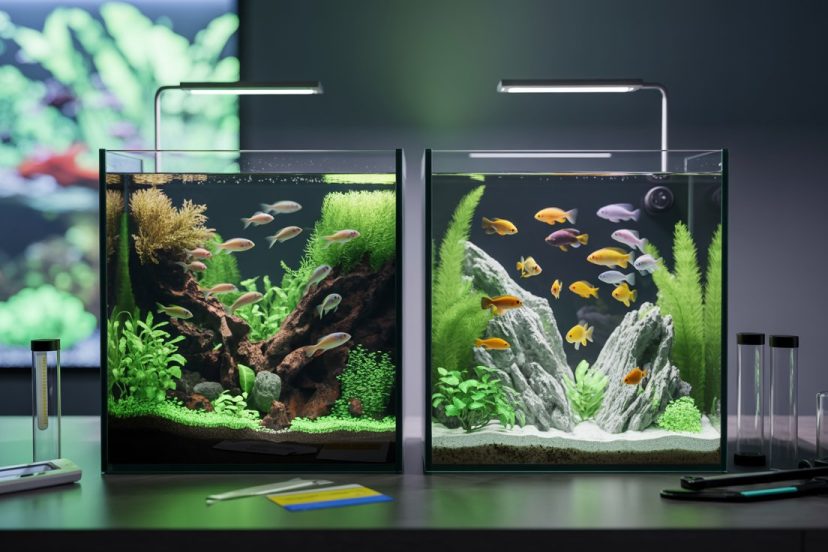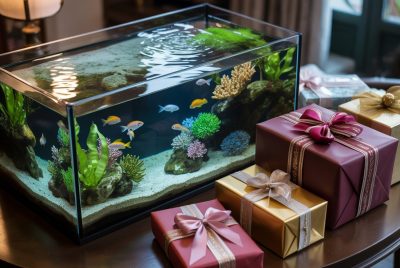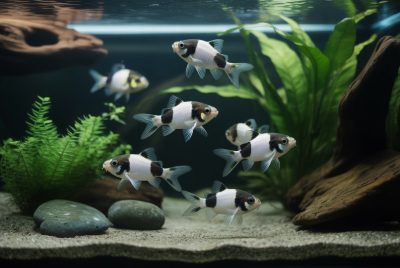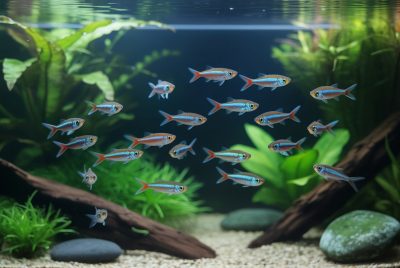Soft vs Hard Water: Which Fish Thrive in Each?
*We may earn a commission for purchases made using our links. Please see our disclosure to learn more.
The shimmering surface of a well-maintained aquarium tells only part of the story. Beneath that glass lies an intricate world where water chemistry determines whether fish flourish or merely survive. The difference between soft and hard water isn’t just a technical detail—it’s the foundation that separates thriving aquatic ecosystems from struggling ones.
Every experienced aquarist remembers that moment of realization: water isn’t just water. The invisible minerals dissolved within create entirely different environments, each suited to specific types of fish. Understanding these differences transforms how we approach fishkeeping, moving from guesswork to informed decision-making.
“The key to successful fishkeeping lies not in forcing fish to adapt to our water, but in creating water conditions that mirror their natural habitat.”
– Marine Biology Research Institute
Key Takeaways
- Water hardness significantly impacts fish health and breeding success
- Soft water (0-6 dGH) suits Amazonian and Southeast Asian species
- Hard water (15+ dGH) benefits African cichlids and Central American fish
- Matching fish to appropriate water conditions reduces stress and disease
- pH levels often correlate with water hardness, affecting fish compatibility
- Regular testing and gradual adjustments prevent shock to aquatic life
Understanding Water Hardness: The Foundation of Aquatic Health
Water hardness refers to the concentration of dissolved minerals, primarily calcium and magnesium, measured in degrees of general hardness (dGH). This seemingly simple measurement creates profound differences in aquatic environments, influencing everything from fish behavior to breeding success.
The Science Behind Water Types
Soft water typically contains 0-6 dGH, creating an environment with minimal mineral content. These conditions naturally occur in areas with granite bedrock, heavy rainfall, or naturally acidic soils. Rivers flowing through rainforests, like the Amazon, exemplify soft water systems where countless tropical species evolved.
Moderately hard water ranges from 6-12 dGH, representing a middle ground that many community aquarium fish tolerate well. This range often occurs in mixed geological areas where some mineral dissolution occurs without reaching extreme levels.
Hard water exceeds 15 dGH, characterized by high mineral concentrations. These conditions develop in limestone-rich regions, creating alkaline environments where specific fish groups have thrived for millennia.
Fish That Flourish in Soft Water Conditions
Amazonian Treasures
The vast Amazon basin produces some of the world’s most beloved soft water fish.
Neon tetras, with their electric blue stripes and red patches, evolved in water so soft it barely registers on hardness scales. These delicate beauties require soft, slightly acidic conditions to display their full coloration and engage in natural schooling behaviors.
Angelfish represent another soft water success story. These graceful swimmers develop their characteristic flowing fins and intense colors only when housed in appropriately soft conditions. Their breeding behavior, from pair formation to fry care, depends heavily on water chemistry that mirrors their native habitat.
Discus fish take soft water requirements to an extreme. These “kings of the aquarium” demand not just soft water, but consistently maintained parameters. Their sensitivity to mineral content makes them excellent indicators of water quality, thriving only when conditions precisely match their needs.
Southeast Asian Specialists
Betta fish showcase how soft water influences behavior and health. Wild bettas inhabit soft, acidic rice paddies and slow-moving streams. When kept in appropriate soft water conditions, these fish display enhanced coloration, improved fin development, and more natural territorial behaviors.
Corydoras catfish from South American tributaries demonstrate the cleaning power of soft water. These bottom-dwellers use their sensitive barbels to search for food, and hard water can damage these crucial sensory organs. Soft water allows their barbels to remain healthy and functional.
Hard Water Champions
African Cichlid Powerhouses
The great lakes of Africa—Malawi, Tanganyika, and Victoria—created unique evolutionary laboratories where hard water specialists flourished.
African cichlids from these lakes require mineral-rich water to maintain their brilliant colors, robust health, and complex social structures.
Mbuna cichlids from Lake Malawi exemplify hard water adaptation. These rock-dwelling fish use high mineral content to maintain their bone density and vibrant yellow, blue, and orange colorations. Their aggressive breeding behaviors and territorial nature reach full expression only in appropriately hard water.
Peacock cichlids demonstrate how hard water affects fish personality. In proper conditions, males develop their spectacular coloration and engage in elaborate courtship displays. The mineral content supports their rapid growth and robust immune systems. high mineral content to maintain their bone density and vibrant yellow, blue, and orange colorations. Their aggressive breeding behaviors and territorial nature reach full expression only in appropriately hard water.
Peacock cichlids demonstrate how hard water affects fish personality. In proper conditions, males develop their spectacular coloration and engage in elaborate courtship displays. The mineral content supports their rapid growth and robust immune systems.
Central American Survivors
Convict cichlids showcase adaptability within hard water ranges. These hardy fish tolerate various hardness levels but truly excel in moderately hard to hard conditions. Their breeding success rates increase dramatically when mineral content supports proper egg development and fry growth.
The pH Connection: Acidity and Alkalinity
Water hardness closely correlates with pH levels, creating compound effects on fish health. Soft water typically maintains acidic pH levels (6.0-6.8), while hard water tends toward alkaline conditions (7.5-8.5).
Soft Water pH Dynamics
Acidic conditions in soft water systems support specific biological processes. Fish from these environments developed digestive systems optimized for slightly acidic conditions. Their gills extract oxygen more efficiently, and their immune systems function optimally within these pH ranges.
Hard Water Alkalinity Benefits
Alkaline conditions in hard water environments provide natural buffering against pH swings. The dissolved minerals create stability that benefits fish requiring consistent water chemistry. Many hard water species evolved enhanced calcium absorption mechanisms that depend on alkaline conditions.
Common Challenges in Water Management
Critical Water Management Issues
Gradual Adjustment Process:
- Fish experience stress when water parameters shift rapidly
- Successful transitions require patience and systematic approaches
- Sudden changes can cause serious health problems regardless of improvement direction
- Aim for no more than 1-2 dGH change per week
Monitoring and Testing Requirements:
- Regular testing becomes essential when managing specific conditions
- Digital meters, test strips, and liquid reagent kits each offer different advantages
- Understanding when and how to use each testing method prevents costly mistakes
- New aquariums require more frequent monitoring until chemistry stabilizes
Water Source Management:
- Many aquarists achieve success through blending different water sources
- Combining soft tap water with harder well water creates custom chemistry
- Using remineralization products allows precise control
- RO systems provide blank canvas for exact parameter control
Creating Species-Appropriate Environments
Soft Water Recreation Methods
Equipment and Techniques:
- Reverse osmosis systems remove dissolved minerals completely
- Peat filtration naturally softens water while adding beneficial tannins
- Driftwood and leaf litter provide ongoing maintenance through tannin release
- Ion exchange resins selectively remove hardness-causing minerals
Natural Soft Water Maintenance:
- Organic acids from driftwood maintain slightly acidic conditions
- Leaf litter provides beneficial compounds supporting fish health
- Regular water changes with RO water maintain consistency
- Gradual tannin release creates naturalistic environment
Hard Water Enhancement Methods
Mineral Addition Techniques:
- Crushed coral substrates slowly dissolve calcium carbonate over time
- Limestone rock formations provide both aesthetic appeal and ongoing mineral supplementation
- Commercial mineral supplements offer precise control over hardness levels
- Aragonite sand maintains alkaline conditions naturally
Benefits of Proper Hard Water Systems:
- Natural buffering against pH swings through dissolved minerals
- Consistent alkaline conditions support specialized fish metabolism
- Enhanced calcium absorption for proper bone development
- Stable water chemistry reduces maintenance requirements
Breeding Considerations
Water chemistry profoundly impacts reproductive success across all fish species. Soft water fish often require specific conductivity levels and pH ranges to trigger spawning behaviors. The low mineral content allows eggs to develop properly without excessive calcium interference.
Hard water species depend on mineral availability for egg shell formation and fry development. Insufficient mineral content leads to poor hatching rates and weak fry that struggle to develop properly.
The Community Tank Balance
Compatible Species Selection
Creating successful community tanks requires understanding water chemistry preferences across all chosen species. Fish with similar hardness requirements generally coexist peacefully, while mismatched species experience ongoing stress that manifests in various health issues.
Compromise Conditions
Moderately hard water (8-12 dGH) offers middle ground for mixed community tanks. While not optimal for extreme soft or hard water specialists, this range accommodates many popular aquarium fish with minimal stress.
Long-term Health Implications
Stress and Disease Resistance
Fish maintained in appropriate water conditions demonstrate stronger immune systems and greater disease resistance. Proper mineral balance supports metabolic functions, while incorrect chemistry creates chronic stress that compromises health.
Growth and Development
Young fish show dramatic differences in growth rates when raised in species-appropriate water conditions. Soft water species develop properly only with adequate mineral restriction, while hard water fish require mineral supplementation for optimal development.
Environmental Considerations
Seasonal Variations
Natural aquatic environments experience seasonal changes in water chemistry. Rainy seasons dilute mineral concentrations in hard water systems, while dry periods concentrate minerals. Understanding these patterns helps create more naturalistic aquarium conditions.
Geographic Origins
Fish collection locations provide valuable clues about water chemistry preferences. Species from limestone-rich regions typically require hard water, while fish from granite mountains or rainforest streams prefer soft conditions.
Advanced Water Chemistry Management
Buffer Systems
Understanding buffering capacity helps maintain stable water chemistry. Soft water systems require careful pH management due to low buffering capacity, while hard water naturally resists pH changes through mineral buffering.
Ion Exchange Principles
Water softening through ion exchange removes calcium and magnesium while adding sodium. This process creates unique chemistry that may not suit all soft water fish, requiring additional consideration in system design.
Troubleshooting Common Issues
Sudden Parameter Changes
Rapid shifts in water chemistry create emergency situations requiring immediate attention. Understanding how to safely adjust parameters prevents fish loss during equipment failures or maintenance errors.
Testing Accuracy
Different testing methods provide varying accuracy levels. Understanding each method’s limitations prevents misinterpretation of results and subsequent inappropriate adjustments.
Future Trends in Water Management
Technology Integration
Digital monitoring systems increasingly offer real-time water chemistry tracking. These systems provide alerts when parameters drift outside acceptable ranges, preventing problems before they become critical.
Sustainable Practices
Environmental consciousness drives development of more efficient water treatment methods. Energy-efficient RO systems and natural biological filtration methods reduce environmental impact while maintaining water quality.
Creating Your Ideal Aquatic Environment
The journey toward perfect water chemistry begins with understanding your chosen fish species’ natural habitats. Research their native waters, understand the geological factors that created those conditions, and work systematically toward recreating those environments.
Start with baseline testing of your source water. Understand what you’re working with before attempting modifications. This knowledge guides equipment selection and treatment strategies while preventing unnecessary complications.
Invest in quality testing equipment and learn to use it properly. Accurate measurements form the foundation of successful water chemistry management. Regular testing schedules prevent problems and track the effectiveness of your management strategies.
Remember that patience proves essential in aquatic chemistry management. Gradual changes protect your fish while moving toward optimal conditions. Rushed adjustments cause more problems than they solve, regardless of good intentions.
Consider the long-term commitments involved in specialized water chemistry maintenance. Soft water systems require ongoing RO water production and mineral management, while hard water systems need consistent mineral supplementation and pH monitoring.
Conclusion
The difference between soft and hard water extends far beyond simple mineral content measurements. These fundamental chemistry variations create entirely different aquatic worlds, each supporting specific fish communities that evolved over millions of years. Understanding and respecting these differences transforms fishkeeping from a hopeful endeavor into a successful, rewarding hobby.
Success in aquatic chemistry management comes not from forcing fish to adapt to available water, but from creating water conditions that allow natural behaviors and optimal health to flourish. Whether maintaining the crystal-clear soft water that neon tetras demand or the mineral-rich hard water that African cichlids require, the goal remains constant: providing fish with environments where they can truly thrive.
The investment in proper water chemistry pays dividends in fish health, breeding success, and the pure joy of observing aquatic life expressing its full potential. Every successful aquarist eventually realizes that water chemistry mastery unlocks the door to extraordinary fishkeeping experiences.
Frequently Asked Questions
Q: How quickly can I change my aquarium’s water hardness?
A: Water hardness changes should occur gradually over several weeks. Sudden changes shock fish and can cause serious health problems. Aim for no more than 1-2 dGH change per week when adjusting hardness levels.
Q: Can I mix soft water and hard water fish in the same tank?
A: While possible with moderate water conditions (8-12 dGH), it’s not optimal for either species. Fish perform best when water chemistry matches their natural habitat requirements. Consider separate tanks for species with vastly different needs.
Q: Do I need expensive equipment to manage water chemistry?
A: Basic water management requires only reliable test kits and appropriate treatments. RO systems and digital monitors provide convenience but aren’t mandatory for success. Start with quality test kits and adjust water gradually using proven methods.
Q: How often should I test my aquarium’s water hardness?
A: Test weekly during initial setup and monthly once conditions stabilize. Increase testing frequency after water changes, equipment changes, or when fish show signs of stress. New aquariums require more frequent monitoring until chemistry stabilizes.
Q: What’s the biggest mistake beginners make with water chemistry?
A: Making changes too quickly represents the most common error. Fish adapt to gradual changes but suffer from rapid parameter shifts. Always adjust chemistry slowly and monitor fish behavior throughout the process.




